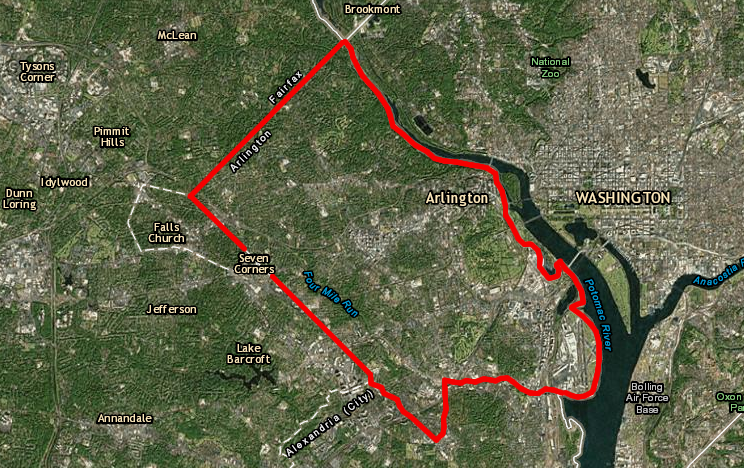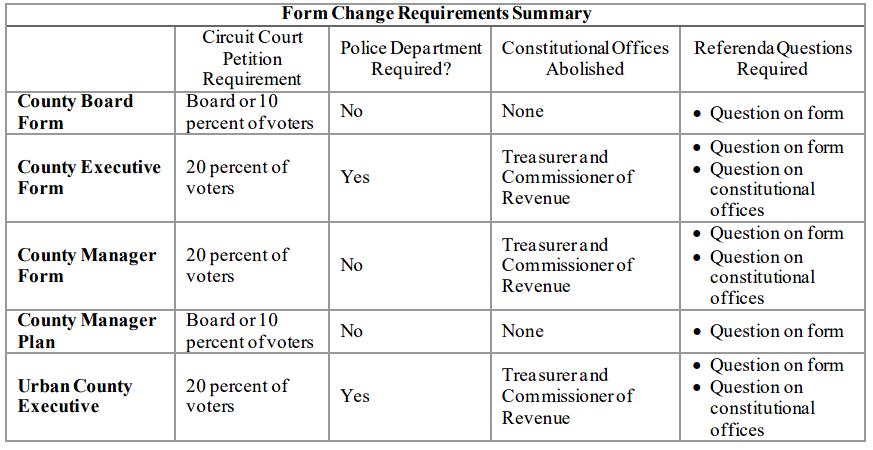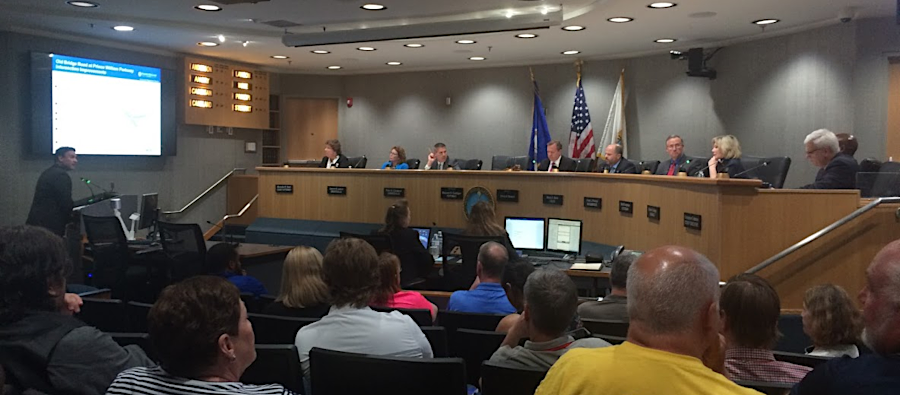
Arlington County was the first to adopt the County Manager Plan form of government, in 1930
Source: ESRI, ArcGIS Online

Arlington County was the first to adopt the County Manager Plan form of government, in 1930
Source: ESRI, ArcGIS Online
Because Virginia courts operate under the Dillon Rule rather than a "home rule" concept, Virginia's local jurisdictions have only the powers granted to them by the state legislature. The Code of Virginia articulates the authority granted to adopt county ordinances, hire/fire personnel, set tax rates, borrow money, operate water/sewage facilities, alter boundaries of local voting precincts, zone land, issue building permits, etc.
The General Assembly also grants specific authorities to towns, cities and occasionally to counties via charters. After voters ratified the Underwood Constitution in 1869, cities were treated as independent political units separate from adjacent/surrounding counties.
Cities and towns in Virginia are granted "uniform charter powers" in the Code of Virginia. A county has such powers only when specifically granted by the General Assembly, a process which the General Assembly first authorized in 1985.1
It is not uncommon for the state legislature to amend individual city and town charters to meet specific requests by local jurisdictions. Of the 95 counties, only Roanoke, Chesterfield, and James City County have obtained charters in order to get greater flexibility under the Dillon Rule.2
The 1902 Constitution of Virginia was amended in 1928 to allow for different forms of county government. The traditional structure of a Board of Supervisors managing staff directly or through a county administrator was adequate for jurisdictions in rural Virginia, where population change was marginal. However, fast-growing counties next to cities and in Northern Virginia were struggling to manage the expanding number of departments required to provide appropriate services.
Arlington County, the smallest and most-densely populated in the state, was the first to take advantage of the flexibility. After the General Assembly passed special legislation, Arlington County voters approved the first "County Manager Plan" of government in the United States in 1930. The voters also decided to elect all five supervisors at-large, eliminating the county's separate magisterial districts.3
The General Assembly created the Virginia Commission on County Government, which concluded that county governments were "inefficient, wasteful, and irresponsible" due largely to structural causes. Offices had fragmented and overlapping responsibilities, while officials were paid based on the fees and commissions they could charge rather than on fixed salaries.
In 1932 the legislature passed the Optional Forms Act of 1932. It authorized the county executive or the county manager form of county government, centralizing administrative responsibilities to allow more-efficient operations. County Managers were given the authority to hire and fire heads of county agencies, without getting approval from the elected Board of Supervisors. The authority of County Executives was more limited; they could just recommend such actions to the elected members on the Board of Supervisors.
If local residents adopted the county executive or the county manager form of local government, elected supervisors gained more control over revenue and spending. Two state constitutional officers - Commissioner of the Revenue and Treasurer - were eliminated and replaced by a county Finance Director. The responsibilities of the three other state constitutional officers - Sheriff, Commonwealth's Attorney, and Clerk of the Circuit Court - were not affected by changing the form of county government.
Henrico County, affected by suburban growth from Richmond, adopted the County Manager form. To qualify for that form, population density must be at least 500 people per square mile. Albemarle County, which surrounded the City of Charlottesville, became the first in Virginia to adopt the County Executive form. Both counties saw immediate cost savings, enabling a reduction of county taxes in the middle of the Great Depression.4

optional forms of county government in Virginia, plus the option of charters, require local approval and grant different authorities/responsibilities to the Board of Supervisors
Source: Loudoun County, Board of Supervisors Business Meeting Information Item (April 20, 2021)
The Code of Virginia now authorizes several more options for county government, as well as the opportunity for counties to obtain a charter that can increase local governing powers.
The County Commission/Traditional form of government, created when the 1870 Constitution eliminated county courts, is used by 84 of Virginia's 95 counties. Voters elect a Board of Supervisors with 3-11 members as their governing body. Supervisors may be elected from individual magisterial districts, from multi-member districts, or at-large from the entire county. The board may choose to hire a county administrator to manage day-to-day operations, or the board itself may perform those duties and rely upon a clerk to document and execute decisions.
The General Assembly has passed specific legislation (county charters) to define the stucture and authorities of county government for Roanoke (chartered in 1986), Chesterfield (chartered in 1987), and James City County (chartered in 1993). Charters and changes to charters must be approved by a two-thirds vote of each house of the General Assembly and signed by the Governor. Chartered counties retain their five constitutional officers - Commonwealth's attorney, clerk of the circuit court, sheriff, treasurer and commissioner of revenue.
Scott, Carroll, Russell, and Grayson counties have adopted the "County Board" form. That form requires that one member be elected at-large, though that person does not have to be the chair of the board. The General Assembly also requires that any county using the County Manager form must appoint a County Administrator. Counties organized under the County Commission/Traditional form of government have the option of appointing, or not appointing, a County Administrator. The maximum number of elected supervisors is 11.
Albemarle County and Prince William County have adopted the "County Executive" form of government. The constitutional office of Treasurer, electd by local residents, is replaced by the Director of Finance appointed by the supervisors. The constitutional office of Commissioner of the Revenue is replaced by either the Director of Finance or by a County Assessor appointed by the supervisors. The constitutional office of Sheriff is retained but with reduced authority, because the supervisors operating in a County Executive form of government must create a police department. The maximum number of elected supervisors is nine.
Voters in Henrico chose the "County Manager Form." The constitutional offices of Treasurer and Commissioner of the Revenue are abolished, as in County Executive form of local government. The county is not required to create a police department, but it must assume responsibility for constructing and maintaining roads (including bridges). The chair of the Board of Supervisors is chosen by the other supervisors, and the maximum number of elected supervisors is nine.
Arlington adopted what is now known as "County Manager Plan" back in 1930. All five constitutional offices are retained, and the county is not required to create a police department. The current requirements include elecing five supervisors from at-large districts.
Fairfax County has an "Urban County Executive." As in the "County Executive" form of government, the constitutional offices of Treasurer and Commissioner of the Revenue are abolished and a police department must be created. In counties using the "County Executive" or "Urban County Executive" form of government, the Chair of the Board is elected specifically to that position. In all other forms, members of the board may choose their chair. Electing up to 11 supervisors is authorized.
Current forms of county government are:5
Urban County Executive - Fairfax County
County Executive - Albemarle, Prince William counties
County Manager Plan - Arlington County
County Manager - Henrico County
County Board - Carroll, Russell Scott, Grayson counties
Charter - Roanoke, Chesterfield, James City counties
County Commission/Traditional - 83 other counties

Board of County Supervisors in Prince William County, considering issuing bonds for parks and transportation projects in 2019